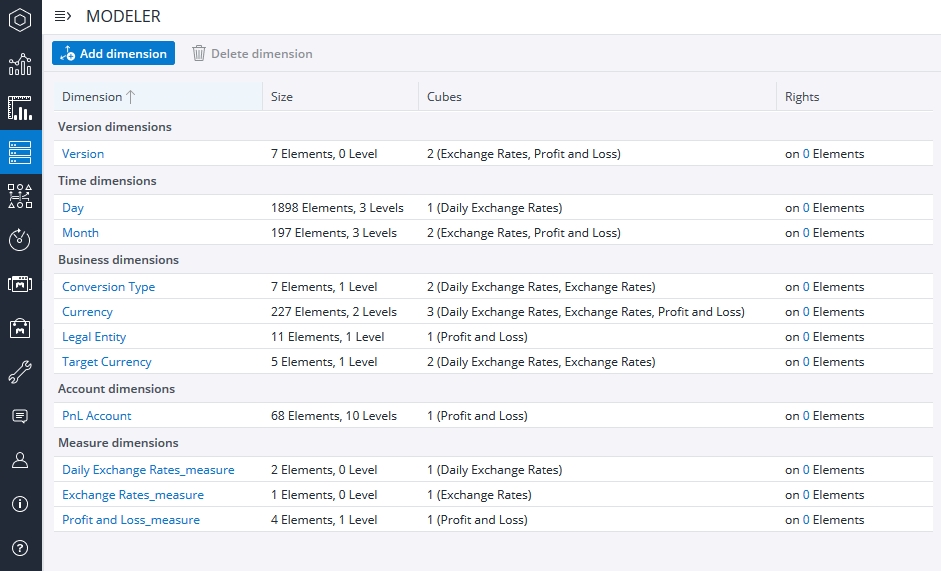Dimensions represent the different perspectives or characteristics of data in a multidimensional data cube. They provide the context for the measures in the cube and help in analyzing data from different viewpoints. Common examples of dimensions include time, geography, product categories, customer segments, etc.
You can view details about every dimension within a database, in table format, in the Modeler. Click Open dimensions on the database card on the Modeler Start page:
The content of Dimensions will be displayed. You can see the number of elements and distribution levels for each dimension; the cubes which contain the dimension; and the number of groups which have non-default rights assigned for the dimension elements:
Clicking on a blue link opens the corresponding dimension.
If types are assigned to dimensions, they will be grouped by type:
Dimension types
If you select a template when you create a dimension, it is automatically assigned a type. If you create a dimension with no template assigned, you can still assign a type after creating it. When you assign a type to a dimension, it does not make any changes to the dimension itself, although Time dimensions can use the Time Editor (see Time description below).
Note: Once selected, dimension types cannot be changed or removed (except for Business type – see description below).
To assign a type, open the dimension in the Modeler, go to Advanced and select the type from the dropdown list. The following options are available:
- Versions - the elements of this dimension represent data sets such as Actual, Budget, or Forecast. They have different origins, such as source systems or planning processes.
- Time - the elements of this dimension represent a time unit, such as day, month, quarter or year, and aggregations thereof. Once selected, this option enables the Time Editor, which allows you to maintain the time dimensions.
- Business - the elements of this dimension represent values broken down in hierarchies, displaying how a company organizes its business. Common business dimensions are Regions, Companies, Cost Centers, Products, or Customers. Dimensions that have been assigned this type can be changed back to "No type assigned."
- Accounts - the elements of this dimension represent ledger accounts, as used by accounting, or similar concepts such as reporting positions or planning items. The hierarchy in an account dimension (also known as a chart of accounts) uses factors for a meaningful aggregation. For example, the factor -1 is used in Profit = Income - Expenses. The factor 0 is used in Total Revenue = Services + Sold Products + Other Revenue + (0* Thereof Interest Revenue).
Note: The list of accounts and its hierarchy are subject to maintenance and can vary over time to reflect changes in the business process. - Measures - the elements of this dimension represent different transactional data information stored in the cube. Similarly to Accounts, you can specify different meanings of measures (such as element type - numeric or string, the units of measurement (amount, units, weight, length), the display format, the aggregation behavior over time, or the calculation formulas. Unlike accounts, there are usually only a few measures and they remain fixed over time.
Updated August 13, 2025

